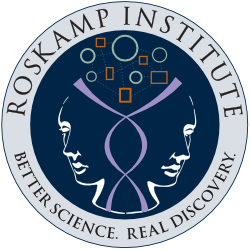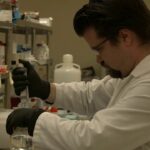What is Alzheimer’s disease?
Alzheimer’s disease (AD) is a brain disorder characterized clinically by progressive cognitive declines in memory, language, and other abilities. Physical changes within the brain include the presence of ß-amyloid plaques, neurofibrillary tangles (NFTs), and cell loss.
What is the difference between Dementia and Alzheimer’s disease?
Dementia is a general term describing an individual who has experienced a decline in their cognitive abilities that leaves them unable to care for themselves. Alzheimer’s disease, or AD, is the most common cause of dementia in the elderly. Other possible causes include vascular disease, Parkinson’s disease, and traumatic brain injury.
What are the earliest signs of Alzheimer’s disease?
Typically, the earliest symptom is difficulty with memory- particularly recalling events or facts recently learned. Long-term memories such as childhood experiences are not impacted in the early stages. Other early signs may include difficulty finding words when speaking or directional confusion while driving. AD is not the only cause of memory problems. Memory problems can result from thyroid disease, vitamin deficiencies, or medication side effects. Therefore it is important to talk to your doctor if you or your loved one is experiencing changes in memory ability.
Who is at risk for AD?
AD is primarily a disease of the elderly, as age is the greatest risk factor. It is currently estimated that close to fifty percent of adults over the age of 85 have some form of dementia including AD. There is also a greater risk for AD associated with a family history of the disorder. Additionally, common gene variations, such as the APOE gene located on chromosome 19, influence risk.
Will I know that I have AD if I get tested for the APOE gene?
The Apolipoprotein E (APOE) gene exists in three common forms or alleles and the e4 allele is a known modifier of age of onset for AD. APOE gene variations have been the most robust findings in late onset AD. However, not all individuals with the e4 form of APOE develop AD, therefore its use in diagnosis of AD has not been validated.
What is early onset AD?
Early-onset AD cases have an age of onset prior to 65, and usually demonstrate a strong family history with an autosomal dominant mode of inheritance, which means the disease is seen in every generation regardless of gender. Early-onset AD is primarily caused by extremely rare genetic mutations in either the ß-amyloid precursor protein gene (bAPP) or one of the presenilin genes (PS-1 & PS-2). These cases are very rare, accounting for less than five percent of all AD cases.
What are the current treatments for AD?
Current treatment is aimed at slowing the disease progression, as there is no cure at present.. Treatment includes medication that helps increase certain brain chemicals affecting memory and reducing secondary damage to the brain from inflammation. These medications are Aricept (donepezil), Exelon (rivastigmine) Razadyne (galantamine- formerly named Reminyl) and Namenda (memantine). Aricept, Exelon and Razadyne are cholinesterase inhibitors which increase a neurotransmitter called acetylcholine in the brain. This helps alleviate some of the symptoms of AD. However, the principal mechanism of action of Namenda is believed to be the blockade of current flow in the brain through channels of N-methyl-d-aspartate (NMDA) and modulation of NMDA receptor activity can increase or decrease excitability of brain circuits. Similar to cholinesterase inhibitors, this also only provides some improvement of AD symptoms. Other treatment includes education and support. Research has shown that treatment works best if the disease is diagnosed and treated early.
Why have a free memory screen?
Aside from AD, there are several other causes for memory changing with age, many of which are treatable- depression, medication side-effects, and vitamin deficiencies are examples.. Why wait and wonder? A twenty minute paper and pencil test may allay your concerns and lead to relief, further evaluation, and/or proper treatment.
How is AD diagnosed?
AD is only diagnosed for certain after death via a brain autopsy. However, a clinical diagnosis by a specialist is often very accurate and the best way to ensure proper treatment. The clinical diagnosis involves seeing a physician (typically a neurologist), who must rule-out treatable causes of the cognitive changes. This is done via laboratory work-up and a neurological examination. A neuropsychological evaluation is also an important component of the process and involves comprehensive testing of cognitive abilities including memory, attention, language, higher order mental functions and emotional status. The third component of a dementia work-up is getting a picture of the brain (e.g., brain MRI or CT). Medicare and/or other insurances typically cover the diagnostic work-up.
Once diagnosed, what should I or my caregiver do?
Receiving a diagnosis of AD is difficult. It is the beginning of a challenging road for both the patient and their loved ones. Patients should try to stay as active as possible. Medications are available that can slow down the disease progression. Participating in clinical trials may also be an important option. Support groups are often helpful for patients in the early stage and for caregivers throughout the course of the illness (which lasts on average about seven years). It may be necessary to seek the advice of an elder law attorney for appropriate legal and health care planning. Education regarding possible community resources is also very important. Click here for Resources for Caregivers.
What is the cause of AD?
There are likely to be several causes of AD but most of the research has focused on the Aβ and tau proteins, which accumulate in the brain of AD patients. These two proteins form two markers for the disease called ß-amyloid plaques and neurofibrillary tangles
What is Ab?
Aβ (also known as ß-amyloid) is the protein which accumulates in the brain of AD cases and is considered a hallmark of this disease. As it accumulates, neurons are damaged leading to their malfunction which subsequently manifests as memory loss and other cognitive change. This process, once begun, is naturally relentless but much evidence suggests that if Aß could be prevented from accumulating the disease would be halted.
What are neurofibrillary tangles (NFTs)?
NFTs are intracellular defects, involving the neurons and can be seen in microscopic sections after staining. These appear as spherical or flame shape objects depending on the location within the brain. Molecular biological analyses show that the NFTs are composed mainly of abnormally-phosphorylated tau protein.
What is Tau?
Tau is one of the main components of NFT, a neuron-specific protein that is the major constituent of neuronal microtubules.
What else can be done?
Some patients opt to participate in research or clinical trials. Research is not the same as treatment. Historically, research has led to important discoveries that make our lives better such as new drugs to treat serious illnesses like heart disease or diabetes. Participating in a clinical trial may or may not help you but it could help others in the future. We offer nume-1488413940 rous clinical trials that are focused on AD-1488413940.

